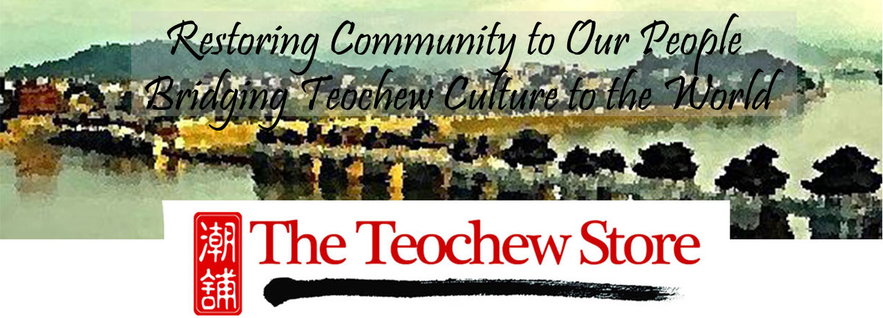Did your Ah-ma wear a hair bun like the grandmother character in our Wa Si Teochew Kia—My First 120 Teochew Expressions flashcards?
你记忆中的阿嫲是不是梳着《我是潮州囝——精选一百二十潮语词语》早教图卡中的“亞媽”(潮语:奶奶)一样的发髻?

Until about a couple of generations ago, all married Teochew women did so as a sign of their marital status. This can be seen clearly in the photograph below taken in the early 1900s and captioned "Teochew married women viewing the sea".
大约两代人以前,这种发髻是已婚潮州女子的标志和象征。在这张摄于清朝末期的“潮州妇人观海图”中,我们可以清楚地看到这点。

Teochew mothers wearing the hair bun are also depicted in the painting titled "Costumes - Swatow" from John Scarth's 1860 travelogue Twelve Years in China, which appears in the opening scene of our Wa Si Teochew Kia—My First 120 Teochew Expressions introductory video.
《我是潮州囝——精选一百二十潮语词语》早教图卡介绍视频的开场,是一张主题为“服饰—汕头”的图画,收录于John Scarth在1860年的游记《中国十二年》中。这幅图画也展现了梳着发髻的潮州母亲。

The hairdo of the Teochew women was a source of fascination and the subject of three photographs taken by travelling photographer John Thomson in 1870, which researchers have determined to be the second, third and fourth images of the Teochew region ever captured on film:
潮州女人的发型造型精致,别具风格。旅行摄影家John Thomson 于1870年在汕头拍下了这三张梳着精美发髻的潮州女子照片。这三张照片已被文化研究学者认定是潮州地区第二、第三和第四张最早的影像。

Before there were handbags, high-heels and trendy clothes, Teochew women wore their hair buns, known as 鬃 zang1, as fashion statements. Styling the hair bun is called 拍 鬃 pah4zang1. There were several different styles and the "turtle zang" (龜鬃 gu1zang1) is said to be in the vogue in the 1940s. This was dressed using a coconut shell (that is shaped like the turtle's) and held together by a silver hairpin and it was popular because the turtle is to the Teochew people a symbol of fortune, prosperity, longevity, wealth and happiness.
在没有手提包、高跟鞋和时髦服饰的年代,潮州女子将他们的发髻(潮语称“鬃 zang1 ”)作为时尚的象征。梳这样的发髻被称为“拍鬃 pah4zang1”。鬃的样式多种多样,其中“龜鬃 gu1zang1”发型在上世纪40年代流行。潮州人把龟当成福、禄、寿、财、喜的圣物。龜鬃是用一个雕刻有吉祥图案的椰子壳将圆髻套住,用银簪或珠簪串紧。椰子壳的形状像龟壳,故被称“龜鬃”。

Sanyangzhi (三陽志) - a gazette of the Teochew region written in the Southern Song period (1127–1279) and believed to be the oldest text of its kind - is cited in the Ming dynasty Yongle Encyclopedia (永樂大典) in reporting of an old custom of local women wearing a tall hair bun when they travelled to the city. The style of hair bun was noted to be different from the ones in China's Central Plain and its surmised that it could have evolved from an even older trend. This is to say the Teochew practice of wearing a hair bun is at least 800 years old!
明代的《永乐大典》引述了被认为潮州最古老的地方志《三阳志》(撰写于南宋期间):“州之旧俗,妇女往来城市者,皆好高髻,与中州异,或以为椎髻之遗风。”说明“拍鬃”作为潮州传统至少流行了八百多年!
Young children who are yet able to read, discover the exciting world we live in through their 5 senses, especially sight.
还不能自主阅读的小朋友,仍然可以通过他们的五感,特别是视觉,来认识这个丰富多彩的世界。
Our Wa Si Teochew Kia—My First 120 Teochew Expressions flashcards, which are developed for children under the age of 3 to learn the Teochew language together with their parents, feature original artwork in which our illustrators try to incorporate elements of the Teochew culture whenever possible.
《我是潮州囝——精选一百二十潮语词语》是一套帮助父母与3岁以下幼儿一起学潮州话的多媒体早教图卡。我们的插画师尽力尝试在配图中融入潮州元素,让小朋友有更多机会接触到我们的文化。
Have you also noticed that the hairdo sported by our adorable Ah Mue (Little Sister) character is inspired by the Teochew opera?
不知您有没有注意到,早教图卡中这位活泼可爱的“亞妹”,她的发型灵感来源于我们的潮州戏?

We wish that through these visual cues, our children will be impressed with an awareness of our people's unique cultural identity. At the same time, we hope to spark those little conversations at home about old memories of what grandma, or great grandma, wore that make every family special.
我们希望通过这些视觉提示,孩子们能认识到我们潮州人独特的文化身份。同时,我们也希望能够引发一些关于家庭旧回忆的小对话,例如讨论我们的祖母或曾祖母的发饰及穿着。这些回忆会让我们的家庭变得更加温馨和特别。
Who knows? Maybe one day Teochew women will again proudly don the turtle bun.
也许有一天,“龜鬃”这一拥有悠久历史的发型会再次受到潮州女孩子的欢迎和喜爱呢?
~o0o~
